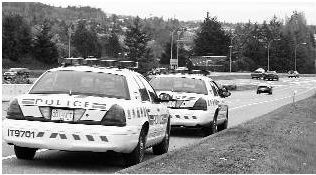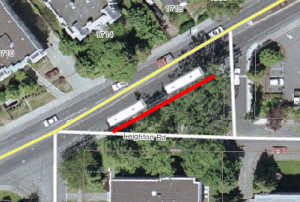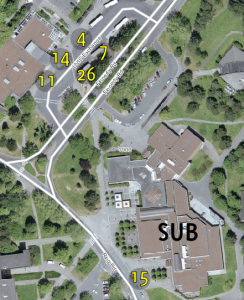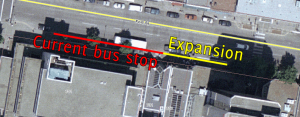Jeff Rubin, the former Chief Economist of CIBC, has a great speech about the realities of high oil prices in the next few years:
Author: corey.burger
Unintended consequence: parking police cars on the shoulder

The Times Colonist has a great piece today about the Integrated Road Safety Unit using their empty cruisers to be phantom speed traps. Slowing down cars is all well and good; the problem is in the implementation. Specifically, the picture from the TC shows two cop cars parked on the shoulder. This is exactly where a bicycle would be, so these cars are actually making it less safe for everybody by forcing that bicycle into the traffic lane, endangering them and the cars coming up behind.
Bowker Creek Open House next week
On January 23rd, the Bowker Creek Initiative will be holding an open house (PDF) to discuss their new plan, the 100-year The Bowker Creek Blueprint. Interestingly, they are holding it in a mall, specifically the Hillside Mall, near the Zellers entrance, from 10am to 2pm. Hourly talks at 10am, 11, 12 and 1 will be held about the plan.
The blueprint itself, all 125 pages of it, can be viewed online (PDF) as can the executive summary (PDF) for those in a rush. I haven’t had a chance to dive into it myself, due to other pressing matters, like the 5th edition of the Official Ubuntu Book, which I co-author, and that little thing called university.
Rocking the boat on Tinto Street
The much discussed rocks on the Tinto St. boulevard are again coming before the committee of the whole this Monday (PDF), after staff was asked to prepare a report into the following options for the area and council opted to defer to allow more time to consult residents. The three options mentioned in the report were:
- Remove the rocks at a cost of $2,000
- 30 degree angle parking with 8 stalls (costing $70,000 with ‘turf stone’ or $21,000 using curb and gutter and asphalt.
- Parallel parking with 15 stalls (costing $65,000 using ‘turf stone’ or $27,000 using curb and gutter and asphalt)
The problem, ostensibly, is parking. The rocks were originally placed there to solve the problem of people parking on the grassy boulevard, something the Mayor raised at a September 2008 Council meeting. Fast forward to a June 2009 Committee of the Whole meeting (PDF) , where a resident approached council about said rocks, wondering why they had been placed there “without consultation with the residents”, in his words. His request triggered the creation of the report, which was given to council at a November 2009 meeting.
However, the story isn’t over. A different group of residents has created a petition to preserve the rocks, as they help preserve limited green space in the municipality. As of last night, the signatures were just shy of thirty, although it isn’t clear how many of them are direct residents of Tinto St or parents of students at the nearby Monterey Middle School.
I personally am in favour of retaining the rocks there. As Shannon Drew, the creator of the petition, pointed out to me in an email, Monterey has designated drop off zones on Monterey and Oliver, the former of which has had quite a bit of work done on it in recent years. Whatever your stance on the issue is, I encourage you to come out Monday night at 7:30pm. The meeting will be held at the Municipal Hall as per usual and with a light agenda save this issue, it should be a short night.
Solutions for empty buses on the 15
Yesterday I talked about some of the teething challenges that the new UVic/Downtown express bus, the 15, nee Dogwood Line, was having. Thankfully a lot of these problems have fairly easy fixes:
- New-ness – This will only be solved by time and it will.
- Advertising – For BC Transit’s part, they could use some of that empty advertising space, both inside and out, to help promote the new line. Metro in Los Angeles has run some pretty good ads and increased choice ridership by a decent amount as a result. Express buses are loved by choice riders. UVic/Camosun and their respective student societies should work to get people on the ground to pamphlet their bus stops and let people know about the new buses, especially with the separated 15 stop at UVic.
- Stops – Most of these are fairly easy fixes as well.
- UVic – As I mentioned, a lot of UVic students are opportunistic riders, so the riders of the 15 will come from the 4, 7, 11 and 14. As can be seen from the image to the right, there is a massive amount of space between the exchange and the SUB. Given there is no space in the exchange for the 15, kicking out another bus to make room would keep the downtown-bound routes together. A logical route would be the 26, which is one of the busier routes, so would benefit from the extra space in front of the SUB, and its route only overlaps with a short section of McKenzie St. with the 39. Moving an existing bus line with established ridership is hard, but is easier than building up a new ridership if nobody knows the bus exists or is hard to easily find.
- Fort @ Douglas – The City of Victoria is fairly transit friendly and is likely to be amenable to removal of parking spots to expand the bus stop here. As a bonus, the spots are in front of the Municipal Finance Authority building, who don’t have the same concerns as a storefront retail business with regards to parking.
- Fort before Richmond – A much harder stop, because the stop is on an island bounded by two roads, so it can’t be easily expanded. One option would be to have the 11 not stop here, as it stops just after Richmond about 100 m away, where the 15 currently does as well. This would keep the 14 and 15 at the same stop.

Stop on Fort before Richmond, with two double-deckers superimposed

- Mistaken schedules – I don’t even know if BC Transit is even aware of this issue up ’til now, but this is a fairly easy fix.
As a last note, I think BC Transit should break out its express routes, the new 15, the 28 Express, the 70, etc. and brand them differently, much like Translink did with the B-Lines.This kind of product differentiation is a great way to attract choice riders, people who could drive but choose to take a bus. Of course, it isn’t news that transit agencies are bad at marketing their own products, a fact which hurts their cause immensely.
(Aerial images are from the CRD Natural Areas atlas, with text and highlighting done with the GIMP and Inkscape)
The empty buses of route 15
Late last year BC Transit introduced a new express route to UVic from downtown, the 15 (previously called the Dogwood Line). While this is only the second week of the new UVic/Camosun term, the buses are very empty, with the 14 still taking the bulk of the passengers along their (mostly) shared route. Why?
- The route is new – New services take some time for people to get used to their existence, so early ridership numbers are not usually good indicator of future performance. However, I don’t think this is the only problem.
- Confusion of signage – While in the planning stages, BC Transit started the process of adding the new route to the electronic signs on the buses. But most of this early work was undone when the transit commission decided against calling it the Dogwood Line, so only a portion of the buses were tagged with 15 UVic/Downtown Express and the rest had Dogwood Line. By this point this appears to have been fixed.
- Advertising – The new route has had zero advertising and barely even got mentioned in any papers. Any notice got shoved alongside the mention of the new 10 route along Bay. There are a bunch of organizations that could have stepped up to the plate for this. First and foremost is BC Transit itself, but the confusion of naming mentioned in the second point didn’t help. UVic Students Society and their Camosun equivalent, plus UVic and Camosun themselves could have gotten involved. So should VIHA, which runs the Royal Jubilee Hospital that lies about half-way along the route.
- Stops – 15 is designed as a limited stop bus. Largely due to lack of space, there are a whole bunch of problems with the specific choices for stops:
- The UVic stop is in front of the SUB, not in the main transit exchange. This is because of lack of space, but better planning could have made this easier. This placement means that the natural ridership of the 15, the current users of the 4, 7, 11 & 14, don’t see the 15 when they are waiting at their usual stops.
- There are missed stops along the way that make no sense. Two of the biggest stops they miss are Fort @ Douglas and Fort just before Richmond. Both are major boarding points for the 14 and to a lesser extent, the 11.
- Mistaken schedules at stops – Some of the downtown stops show the 15 on the printed schedule at the stop but are not actually stops for the 15. This just adds confusion.
None of these are intractable problems and they will be solved, one or another. Tomorrow I will talk about some of the solutions that I see. The addition of the 15 has been a long time in coming and I am glad BC Transit is finally starting to think more about express & limited stop buses.
MSR and INI
There are a lot of confusing terms associated with the Uplands sewage separation project, but two of the most common acronyms that were tossed around were MSR and INI. In the hopes of lifting some of that confusion, a quick debrief:
INI or Inflow and infiltration. Essentially the water that leaks into the system from the cracks in the pipes, bad joints, manhole covers, etc. CRD has a good page on INI.
MSR or Municipal Sewage Regulation: The provincial law that governs sewage systems, both sanitary and storm. This is the law that is forcing Oak Bay to twin the Uplands sewer. The full regulations and FAQ are available online.
Chief Administrative Officer Bill Cochrane to retire
Yesterday evening the mayor announced that in a few months, shortly after the budget, Bill Cochrane, the CAO for the Municipality of Oak Bay for the past 10 years will retire. It isn’t clear to me how long he has worked for the municipality, but 10 years is the lowest number. Recent shakeups in the past year at Victoria and Vancouver city halls senior levels have caused changes in culture, especially in Vancouver, so what effect it has on a smaller municipality should be interesting to watch. Councillor’s Jensen and Herbert (Update: Braithwaite will be sitting on this committee, not Herbert) with the Mayor will be leading the search for a replacement.
In Quotes: Tonight’s council on Oak Bay Lodge and Uplands sewage
As will undoubtedly be reported tomorrow in the TC, Oak Bay Council elected to delay the Uplands sewage project, mostly by simply deciding to not do anything. This almost certainly means that that the grant from the federal and prov. governments is gone, as is a low-pressure system. What it means beyond that isn’t certain. As I mentioned earlier in the day, also up was a presentation by VIHA on Oak Bay Lodge as well as a few other things. I will do some more reporting on them tomorrow, but tonight I thought I would share with you a few of the choicer quotes from the evening:
Building a new facility [to replace Oak Bay Lodge] is the best use of resources
VIHA CEO Howard Waldner, on whether or not replacement is a better option to refurbishment
It is a matter for the new owner and [Oak Bay] council
CEO Waldner, essentially dodging VIHA’s responsibility in determining the best use of the Oak Bay Lodge lands
We have no knowledge of that
Waldner on the reported hard-ball tactics that property owners adjoining Oak Bay Lodge have been receiving
We [Oak Bay Council] have also received an imperative from Uplands residents: no pumps
Councillor Cassidy on the provincial/federal imperative to separate the Uplands sewage system
We [Oak Bay Council] should have said no
Councillor Herbert on what they should have told the province when the deadline was moved back to 2011
Whether we like it or not, it has to be done
Councillor Jensen on the inevitability of sewage separation
We [Oak Bay Council] haven’t heard from the rest of the community
Councillor Ney on consulting the wider Oak Bay community on the Uplands sewage project
It was easier to ask tough questions about Oak Bay Lodge
Councillor Copley at the start of her remarks on sewage treatment. Copley has a parent in Oak Bay Lodge
I would have liked to have a more made-in-Canada solution
Copley on the usage of American-made pumps in the proposed low-pressure system
Gas lights were once the gold standard
Councillor Braithwaite on the “best” sewage system for the Uplands
If there is any fault in communication, it always comes back to the mayor
Mayor Causton’s mea culpa on the public consultation side of the Uplands sewage treatment project
I don’t want any of the comments by council to reflect badly on the staff
Causton praising staff and consultants on their work on the sewage issue, after council essentially voted to defer the issue by merely receiving the report recommending a low-pressure system without further action
Sewage, Oak Bay Lodge and more at tonight’s council
Tonight’s council agenda (PDF) is very full and with the dual contentious issues of Uplands sewage and Oak Bay Lodge, it should be interesting. First up is VIHA with a presentation on what happens with Oak Bay Lodge, which is likely to be followed by some interesting debate amongst council members, who haven’t yet stated any formal positions on the matter.
This is also the night for deciding on Uplands sewage, after last Wednesday’s marathon until almost midnight. Councillor Cassidy has already stated his position on supported a gravity feed system over a low-pressure one, but none of the other councillors or the mayor have been that explicit. The choice is a tough one, because the gravity system likely requires a tax increase, ballparked in the neighbourhood of 10% per household for the entire of Oak Bay but the low-pressure system is nearly universally opposed by Uplands residents and requires ongoing maintenance.
Also up on the agenda are the transportation priorities committee, which Councillor Jensen has proposed, the usual host of property bylaw variances, a request from the Oak Bay Lawn Bowling Club for financial assisstance (something not likely to meet favour with Councillor Braithwaite, who feels Oak Bay gives enough to the club already, given it’s membership), and the potential of hiring a consultant to work with the school district on the Oak Bay High replacement project.
I suspect that it might just be a little busy tonight, so if you want to come, make certain you arrive early to get your seat.
